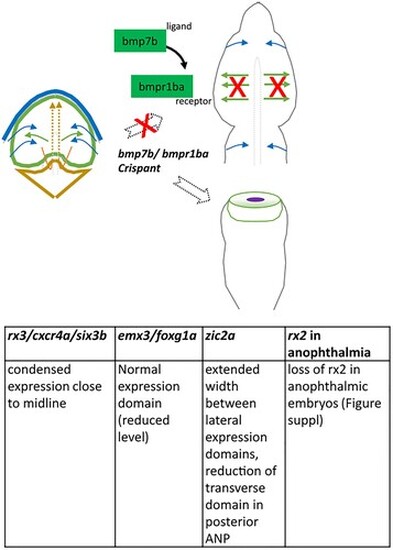Fig. 5
- ID
- ZDB-FIG-250728-140
- Publication
- Kyrychenko et al., 2025 - Holoprosencephaly and cyclopia in bmp7b and bmpr1ba Crispant zebrafish
- Other Figures
- All Figure Page
- Back to All Figure Page
|
Schematic and tabular summary of major findings: In Crispants for bmp7b (and bmpr1ba) the separation of the eye field fails during early development and the development results in cyclopia. Genes expressed in the eye field rx3, cxcr4a and six3b are condensed to the midline in Crispants (shown for bmp7b). The morphology of the zic2a expression domain of was also found altered in Crispants. Zic2 was found to be important for prechordal plate development and is thus a HPE-related gene (Warr et al. Citation2008). In Crispants, however, the domain was showing an extended width, while the domain marking the posterior end of the ANP was largely missing. This domain is corresponding to the presumptive hypothalamic domain, which is important for ANP splitting via a subduction movement (England et al. Citation2006). Alcamb (formerly nlcam), which in Medaka was found to be suppressed in retinal precursors (Brown et al. Citation2010), was found homogeneously expressed in the ANP of control zebrafish embryos and reduced in Crispants. Genes expressed in the prospective telencephalic domain, emx3 and foxg1a, show an overall normal morphology of their expression domain (in terms of separation from the midline) but, however, reduced levels of expression intensity. In cases of Crispants resulting in anophthalmia, no ‘crypt-oculoid’ was found. |

